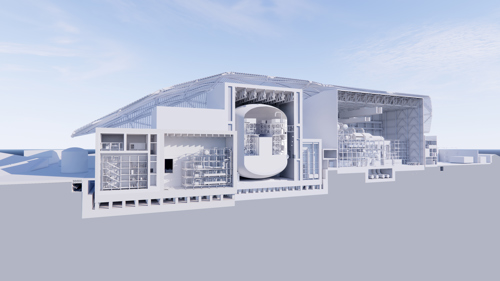
In a breakthrough that could reshape Britain’s energy landscape, Rolls-Royce has developed innovative Small Modular Reactors (SMRs) that promise to power a million homes each for 60 years, while experts claim political and regulatory hurdles are preventing a potential energy revolution.
These compact nuclear reactors, each generating 470 megawatts of power, represent a significant advancement in nuclear technology, combining enhanced safety features with emission-free energy production. However, their deployment faces delays despite growing concerns over Britain’s energy costs and security.
“SMRs could transform our approach to nuclear power generation,” said Dr. Victoria Reynolds, nuclear policy director at the UK Energy Institute. “Their factory-built design significantly reduces construction time and costs compared to traditional nuclear plants.”
The technology arrives at a critical juncture for British energy policy. Current data shows UK households paying some of Europe’s highest energy rates, with renewable energy subsidies averaging £300 per household annually. This has sparked debate about the nation’s energy strategy and its impact on living standards.

Rolls-Royce’s SMR design incorporates several revolutionary features. Unlike traditional nuclear plants, these modules can be manufactured in controlled factory conditions and transported to sites, potentially slashing construction costs and timelines. Their compact size requires minimal land use while maintaining robust safety standards through passive cooling systems and advanced containment measures.
“The economic implications extend beyond energy production,” explained Professor James Harrison, energy economics expert at Imperial College London. “Britain could position itself as a global leader in SMR technology, creating thousands of high-skilled jobs and export opportunities.”

However, the path to deployment faces multiple challenges. Industry analysts point to three main hurdles: stringent regulatory requirements, public perception concerns, and competition from established renewable energy sectors. The UK government’s current focus on wind and solar development has raised questions about resource allocation and energy policy priorities.
Environmental groups remain divided on the role of nuclear power in achieving net-zero emissions. While some advocate for SMRs as a reliable, carbon-free baseload power source, others express concerns about nuclear waste management and long-term safety implications.
Power Output and Design:
- The Rolls-Royce SMR is designed to generate 470 megawatts (MW) of electricity, enough to power approximately one million homes
- It is a pressurized water reactor (PWR) that uses light water as both the coolant and moderator
- The SMR is factory-built, with modules transported to the site for assembly. This modular approach reduces construction time and environmental impact
- It occupies one-tenth the size of a conventional nuclear power plant, making it suitable for smaller sites
- The design incorporates passive safety systems, such as gravity-driven cooling and passive residual heat removal, ensuring high safety standards
- It avoids the use of boron in the primary coolant, reducing tritium production and simplifying liquid effluent treatment
- The target construction time is 500 days, with an overall build time of four years (two years for site preparation and two years for construction and commissioning)
- Rolls-Royce aims to deploy SMRs globally, with plans to sell hundreds of units by 2050
- The estimated cost for the fifth unit built is £1.8 billion, significantly lower than traditional large-scale reactors like Sizewell C, which costs £22 billion
- Rolls-Royce has secured £210 million in government funding, matched by £195 million from private investors, to develop the design
- The SMR is emission-free during operation and supports the production of green hydrogen and synthetic fuels, aiding in the decarbonization of transport
- It uses mechanical draft cooling towers, reducing water abstraction and environmental impact compared to direct cooling systems
- The design is undergoing the Generic Design Assessment (GDA) by the UK’s Office for Nuclear Regulation (ONR) and the Environment Agency. Step 2 of the GDA was completed in July 2024, with Step 3 expected to conclude by December 2026. The GDA process ensures the design meets high safety, security, and environmental standards before deployment
- Rolls-Royce has identified four potential sites in the UK for SMR deployment, including Trawsfynydd, Sellafield, Wylfa, and Oldbury. The company is also exploring international opportunities for SMR deployment
- The reactor uses low-enriched uranium dioxide (UO2) as fuel
- Spent fuel is stored in a spent fuel storage pond for up to 10 years, with plans for eventual disposal in a geological disposal facility (GDF)
- The SMR is expected to provide stable baseload power for at least 60 years, complementing renewable energy sources like wind and solar
- It aims to reduce reliance on fossil fuels and enhance energy security in the UK and beyond
The technology has already attracted international attention, with several countries expressing interest in Rolls-Royce’s design. France’s successful nuclear program, which provides relatively low-cost electricity, offers a compelling case study for nuclear energy’s potential role in national power strategies.
“We’re seeing a complex interplay between different energy technologies,” noted Dr. Sarah Matthews, senior researcher at the Energy Policy Institute. “SMRs could complement renewable sources, providing stable baseline power when wind and solar generation fluctuates.”
The UK government’s approach to energy transition involves balancing multiple factors, including cost, security, environmental impact, and public acceptance. While SMRs form part of this strategy, they compete with other technologies like hydrogen and carbon capture and storage for investment and political support.
Recent analysis suggests that strategic deployment of SMRs could significantly reduce Britain’s carbon emissions while providing stable, affordable energy. However, experts emphasize that successful implementation requires careful consideration of regulatory frameworks, public engagement, and integration with existing energy infrastructure.
As Britain continues its journey toward net-zero emissions, the role of Rolls-Royce’s SMRs remains a crucial yet contested element of the nation’s energy future. With mounting pressure to address both climate goals and energy costs, the technology offers a promising solution that awaits full political and regulatory support.
References:
Small Modular Reactors – Rolls-Royce
Nuclear Small Modular Reactors (SMRs) Global Market 2025-2045, Yahoo Finance
Rolls-Royce SMR Regulatory Progress, UK Office for Nuclear Regulation (ONR)







